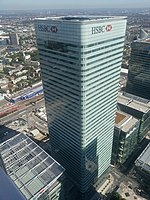One Churchill Place

One Churchill Place is a 156 m tall skyscraper with 32 floors, serving as the headquarters of Barclays Bank. It is in the Docklands area of London Borough of Tower Hamlets in Canary Wharf. The building is the 13th-tallest office block in the United Kingdom and the sixth tallest building in the Docklands. The building was formally opened in June 2005 by the Chairman of Barclays, Matthew Barrett, and merged Barclays offices across London into one building. The former corporate HQ was at 54 Lombard Street in the City of London. Barclays occupy 100% of the building; floors 18-20 were previously leased to BGC Partners/Cantor Fitzgerald. Several floors were previously occupied by the Olympic Delivery Teams prior to 2012, and a portion of level 17 was occupied by the Metropolitan Police.
Excerpt from the Wikipedia article One Churchill Place (License: CC BY-SA 3.0, Authors, Images).One Churchill Place
Woodstock Terrace, London Poplar
Geographical coordinates (GPS) Address Nearby Places Show on map
Geographical coordinates (GPS)
| Latitude | Longitude |
|---|---|
| N 51.5055 ° | E -0.014 ° |
Address
Woodstock Terrace 33
E14 0AD London, Poplar
England, United Kingdom
Open on Google Maps









